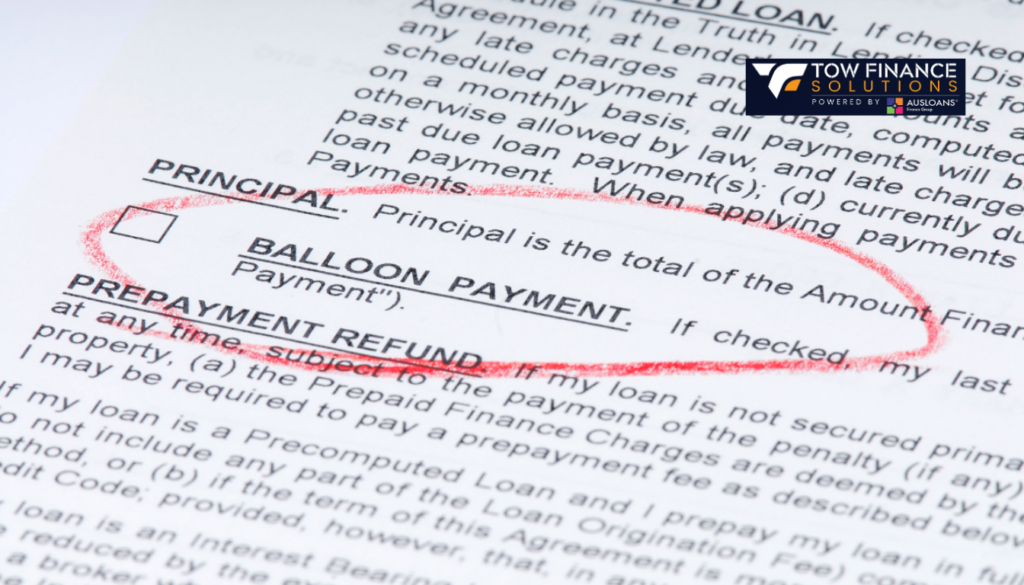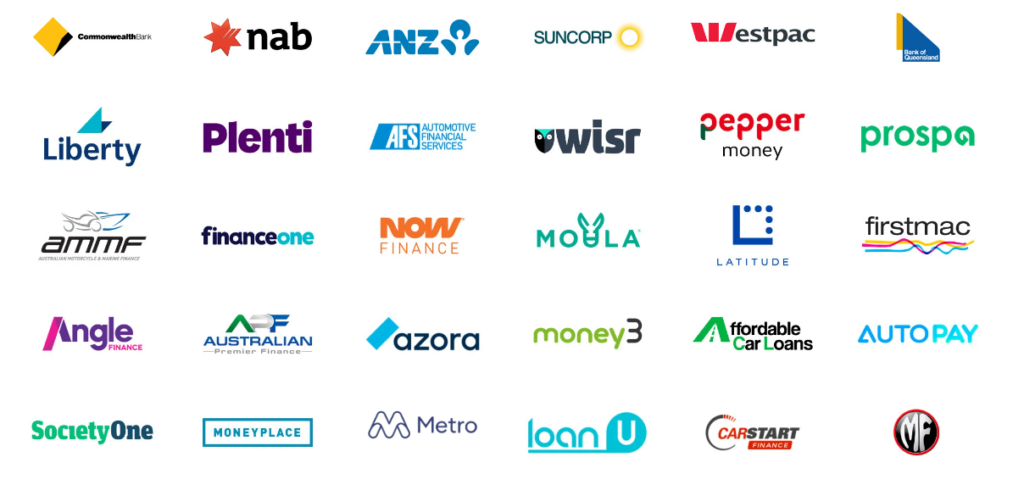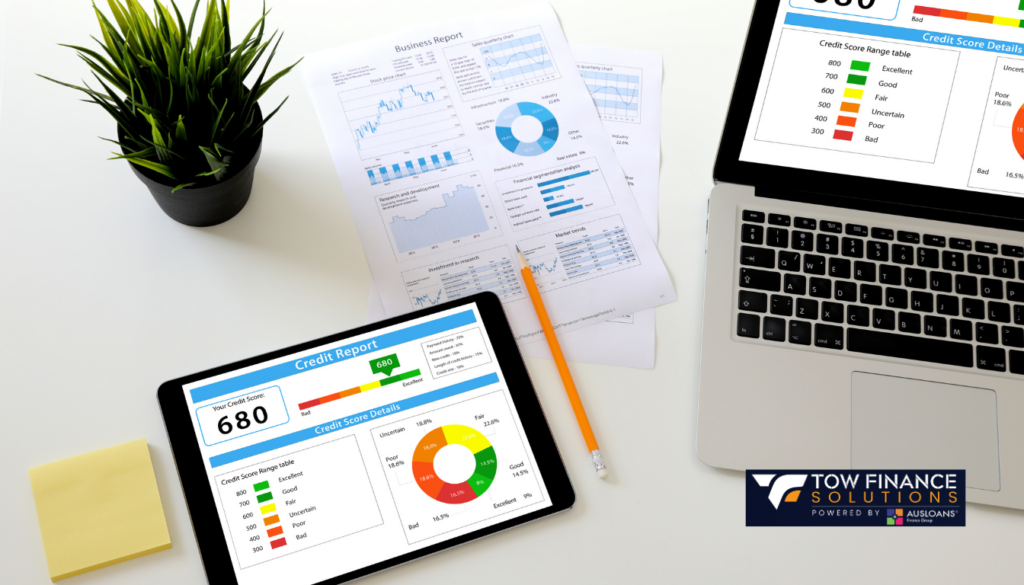Balloon Payments Explained
The Complete Guide to Lower Monthly Payments and Smart Vehicle Financing
July 17, 2025
Vehicle financing decisions can significantly impact your monthly budget and long-term financial health, particularly when considering the various payment structures available in today’s competitive lending market. Among the most misunderstood yet potentially beneficial financing options is the balloon payment structure, which offers immediate cash flow advantages but requires careful consideration of future financial obligations and exit strategies.
Tow Finance Solutions has helped thousands of Australians navigate complex financing decisions through their network of over 40 lenders, providing the expertise needed to match financing structures to individual circumstances and goals. Understanding balloon payments becomes particularly important when considering expensive vehicles, business assets, or situations where preserving cash flow takes priority over minimizing total interest costs. This knowledge empowers borrowers to make informed decisions that align with their financial strategies and lifestyle requirements.
Overview
This comprehensive guide examines every aspect of balloon payment financing, from the fundamental mechanics to strategic applications and potential pitfalls. We’ll explore how balloon payments work within different loan structures, analyze the financial implications for various borrower profiles, and provide practical guidance for determining whether this financing approach suits your specific circumstances.
You’ll discover the mathematical principles behind balloon payment calculations, learn about the different types of balloon structures available, and understand the exit strategies that successful borrowers employ. We’ll also cover the regulatory framework protecting consumers, examine real-world scenarios where balloon payments excel, and provide tools for evaluating alternatives that might better serve your financial objectives.
Find The Best Deal

With over 10 years of industry experience we are a leading independent broker with a diverse panel of 40 + lenders to find you the best solution, tailored to you and your goals!
Key Takeaways
- Balloon payments reduce monthly payments by deferring a significant portion of the principal to the loan’s end
- Lower monthly payments can improve cash flow for businesses and individuals with fluctuating income
- Three main exit strategies exist: refinancing, selling the asset, or paying the balloon amount in full
- Business users may benefit from tax advantages and preserved working capital through balloon structures
- Careful planning and professional guidance help avoid potential financial difficulties at loan maturity
- Interest costs are typically higher with balloon payments compared to traditional fully-amortizing loans
Understanding Balloon Payment Fundamentals

How Balloon Payments Work
A balloon payment represents a large, predetermined amount due at the end of a loan term, typically comprising 20-50% of the vehicle’s original value. This structure allows lenders to reduce monthly payments by calculating them on only a portion of the vehicle’s value, with the borrower responsible for the remaining balance when the loan matures. The balloon amount is usually based on the expected residual value of the vehicle at loan completion.
The monthly payment calculation treats the balloon amount as if it will be paid by selling or trading the vehicle at loan maturity. This approach assumes that the vehicle will retain sufficient value to cover the balloon payment, though market conditions, vehicle condition, and mileage can all affect actual resale values. Understanding this fundamental assumption helps borrowers evaluate the risks and benefits of balloon financing.
Interest charges apply to the full loan amount throughout the term, meaning borrowers pay interest on both the monthly payment portion and the balloon amount. This structure results in higher total interest costs compared to traditional loans but provides the immediate benefit of reduced monthly obligations. The trade-off between current cash flow and long-term costs represents the core decision point for balloon payment consideration.
Types of Balloon Payment Structures
Fixed balloon payments establish a predetermined amount due at loan maturity, providing certainty for budgeting and planning purposes. This structure works well for borrowers who prefer predictable obligations and can plan for the balloon payment through savings, refinancing, or asset sale strategies. The fixed nature eliminates uncertainty about the final payment amount but requires careful evaluation of the vehicle’s likely value at loan maturity.
Residual value balloons link the final payment to a percentage of the vehicle’s original purchase price, typically ranging from 20% to 50% depending on the loan term and vehicle type. Shorter terms generally support higher residual percentages, while longer terms require lower residuals to account for additional depreciation. This structure aligns the balloon payment with industry depreciation expectations.
Business balloon loans often incorporate tax-effective structures that maximize deductions while preserving cash flow for operations. These arrangements may include options for extending the balloon period, restructuring payments, or converting to operating leases at maturity. The additional flexibility reflects the complex cash flow patterns and tax planning requirements of business borrowers.
Balloon Payment Characteristics:
- Large final payment typically 20-50% of original vehicle value
- Reduced monthly payments throughout the loan term
- Interest charged on full loan amount including balloon portion
- Multiple exit strategies available at loan maturity
- Higher total interest costs compared to traditional financing

Financial Impact and Cash Flow Benefits
Monthly Payment Reduction Analysis
The primary attraction of balloon payment financing lies in the substantial reduction in monthly obligations, often decreasing payments by 30-60% compared to traditional fully-amortizing loans. This reduction occurs because monthly payments only service the interest and a portion of the principal, with the balloon amount deferred until loan maturity. The magnitude of reduction depends on the balloon percentage, loan term, and interest rate structure.
For a typical $50,000 vehicle with a 40% balloon payment, monthly payments might reduce from $1,200 to $750 over a five-year term, creating $450 monthly cash flow savings. This improvement can make higher-value vehicles accessible to borrowers with limited monthly budgets or provide additional working capital for business operations. The cumulative cash flow benefit over the loan term can be substantial.
The improved cash flow enables borrowers to pursue other financial opportunities, whether investing in business growth, maintaining emergency reserves, or simply managing household expenses more comfortably. This flexibility proves particularly valuable for seasonal businesses, commission-based income earners, or individuals transitioning between career phases where monthly budget constraints limit traditional financing options.
Business Applications and Tax Considerations
Business borrowers often find balloon payment structures particularly advantageous due to the combination of improved cash flow and potential tax benefits. The reduced monthly payments preserve working capital for operational needs, inventory purchases, or growth investments while the interest deductions remain fully available. This capital preservation can prove more valuable than the additional interest costs associated with balloon financing.
Tax planning opportunities may include timing the balloon payment to coincide with favorable tax periods, structuring the loan to maximize depreciation benefits, or coordinating the vehicle replacement cycle with business expansion plans. Professional tax advice helps optimize these strategies within the regulatory framework while ensuring compliance with Australian Taxation Office requirements.
The flexibility to refinance, extend, or restructure the balloon payment at maturity provides business borrowers with options that align with changing operational needs. This adaptability proves particularly valuable for growing businesses where future cash flow patterns may differ significantly from current circumstances, allowing financing structures to evolve with business requirements.
Cash Flow Advantages:
- Monthly payment reductions of 30-60% compared to traditional loans
- Preserved working capital for business operations and investments
- Improved budget flexibility for seasonal or variable income patterns
- Tax planning opportunities for business borrowers
- Enhanced access to higher-value vehicles within monthly budget constraints
Exit Strategies and Maturity Options
Refinancing the Balloon Payment
Refinancing represents the most common exit strategy for balloon payment loans, allowing borrowers to convert the balloon amount into a new loan with manageable monthly payments. This approach works well when the borrower’s financial situation has improved, interest rates have decreased, or when keeping the vehicle provides ongoing value. The refinancing process typically resembles the original loan application but focuses on the balloon amount rather than the full vehicle value.
Lenders evaluate refinancing applications based on current credit worthiness, vehicle condition and value, and the borrower’s ability to service the new loan payments. The vehicle’s current market value becomes critical, as lenders typically require the loan amount to remain below the vehicle’s worth. Professional valuations may be necessary to establish refinancing eligibility and terms.
Interest rates for balloon refinancing may differ from the original loan terms, reflecting current market conditions and the borrower’s updated credit profile. Some lenders offer predetermined refinancing terms at loan origination, providing certainty about future options while others evaluate refinancing requests based on conditions at maturity. Understanding these differences helps borrowers select appropriate initial loan structures.
Vehicle Sale and Trade Strategies
Selling or trading the vehicle at loan maturity represents another common exit strategy, particularly when the borrower wants to upgrade to a newer model or no longer needs the vehicle. Success depends on the vehicle’s market value exceeding the balloon payment amount, creating equity that can be applied to a new purchase or returned to the borrower as cash.
Market conditions, vehicle maintenance, and mileage significantly influence resale values and the success of sale-based exit strategies. Borrowers who maintain their vehicles well and stay within anticipated mileage ranges typically achieve better results than those who neglect maintenance or exceed expected usage patterns. Professional pre-sale preparation can maximize vehicle value and sale proceeds.
Trade-in transactions through dealers often provide convenience but may yield lower net proceeds than private sales. The trade-in value must exceed the balloon payment for the strategy to work, though dealers may offer additional financing to bridge small gaps. Understanding market values and negotiation strategies helps borrowers optimize their exit results regardless of the chosen sale method.
Exit Strategy Options:
- Refinancing the balloon amount into a new manageable loan structure
- Selling the vehicle privately to maximize proceeds and equity recovery
- Trading the vehicle at a dealership for convenience and immediate replacement
- Paying the balloon amount in full if financial circumstances permit
- Combination strategies involving partial payment and reduced refinancing amounts
Risk Assessment and Potential Pitfalls

Market Value Risk and Depreciation
The primary risk in balloon payment financing lies in the potential gap between the balloon amount and the vehicle’s actual market value at loan maturity. If the vehicle depreciates faster than anticipated or market conditions deteriorate, borrowers may face negative equity where the balloon payment exceeds the vehicle’s worth. This situation complicates exit strategies and may require additional funds to complete the transaction.
Several factors influence depreciation rates beyond normal market forces, including changes in fuel efficiency standards, new technology adoption, manufacturer recalls, or shifts in consumer preferences. Vehicles with higher-than-average depreciation rates create greater risks for balloon payment borrowers, making careful vehicle selection and balloon percentage consideration essential for risk management.
Economic downturns or industry disruptions can affect vehicle values across entire market segments, creating widespread negative equity situations that individual borrowers cannot control. The 2020 pandemic demonstrated how external events can dramatically alter vehicle markets, though subsequent supply shortages also showed how values can recover unexpectedly. These examples highlight the inherent uncertainty in predicting future market conditions.
Financial Hardship and Limited Options
Borrowers experiencing financial difficulties during the loan term may find balloon payment structures more challenging than traditional loans due to the limited equity accumulation and refinancing requirements at maturity. Unlike fully-amortizing loans where payment difficulties can often be resolved through asset sale, balloon loans may trap borrowers in negative equity situations that prevent clean exits.
Early termination of balloon payment loans often results in significant financial penalties due to the large outstanding balance and prepayment fees. These costs can exceed the vehicle’s current value, making voluntary surrender or early sale uneconomical. Understanding these limitations helps borrowers evaluate their risk tolerance and financial stability before committing to balloon structures.
The concentration of financial obligation at loan maturity creates a specific risk point that requires planning and preparation. Borrowers who fail to prepare adequate exit strategies may face forced refinancing at unfavorable terms, distressed asset sales, or default situations that damage credit ratings and financial standing. Proactive planning and professional guidance help mitigate these risks.
Comparing Balloon Payments to Alternative Financing
Traditional Fully-Amortizing Loans
Traditional car loans structure payments to gradually reduce the principal balance to zero over the loan term, creating equity accumulation and eliminating balloon payment obligations. Monthly payments are higher than balloon structures but total interest costs are typically lower due to the shorter effective loan term and principal reduction throughout the payment period. This approach suits borrowers who prioritize total cost minimization and prefer predictable, consistent obligations.
The equity accumulation in traditional loans provides flexibility for early termination, trade-ins, or emergency sales throughout the loan term. Borrowers can often recover funds or break even on vehicle sales during the loan period, providing financial security that balloon structures cannot match. This liquidity advantage proves valuable for borrowers with uncertain future circumstances or those who change vehicles frequently.
Traditional loans align payment obligations with asset ownership, creating a clear path to debt-free vehicle ownership without future balloon obligations. This structure appeals to borrowers who prefer simple, straightforward arrangements without complex exit strategy requirements or market value risks. The psychological benefit of progressive debt reduction also appeals to many borrowers who value the security of increasing ownership equity.
Lease Arrangements and Operating Agreements
Vehicle leasing provides many of the cash flow benefits of balloon financing without the ownership responsibilities or market value risks. Lease payments typically equal or exceed balloon loan payments but eliminate the maturity obligations and provide guaranteed vehicle return options. This structure suits borrowers who prefer predictable costs and regular vehicle updates without long-term financial commitments.
Operating leases offer additional benefits for business users, including potential off-balance-sheet treatment, maintenance packages, and simplified fleet management. The bundled services and predictable costs can provide value beyond simple financing, particularly for businesses that prefer to focus on operations rather than asset management. Tax treatment may also favor lease arrangements for certain business structures.
The lack of ownership equity in lease arrangements means that all payments represent consumption rather than investment, making leases more expensive over extended periods for borrowers who prefer long-term vehicle ownership. However, the elimination of depreciation risk and disposal responsibilities may justify the additional cost for borrowers who value convenience and predictability over equity accumulation.
Financing Comparison Factors:
- Monthly payment amounts and cash flow impact on household or business budgets
- Total cost of finance including interest, fees, and opportunity costs
- Equity accumulation and ownership benefits versus risk exposure
- Exit flexibility and early termination options throughout the agreement term
- Tax implications and business accounting treatment differences
Credit Requirements and Assessment Criteria
Lenders typically apply similar credit requirements to balloon payment loans as traditional financing, though some may impose stricter standards due to the concentrated risk at loan maturity. Credit scores, income stability, employment history, and existing debt obligations all influence approval decisions and interest rate offerings. The ability to demonstrate planning for the balloon payment may also factor into approval decisions.
Income verification focuses on the borrower’s ability to service monthly payments throughout the loan term, but lenders increasingly consider balloon payment planning as part of the assessment process. This evaluation may include reviewing savings patterns, asset accumulation, or business cash flow projections that support balloon payment strategies. Professional borrowers with predictable income patterns often receive favorable consideration.
The vehicle’s expected residual value and the balloon percentage relative to purchase price influence lender risk assessment and approval criteria. Conservative balloon amounts on vehicles with strong resale histories typically receive better terms than aggressive structures on depreciation-prone vehicles. Lenders may limit balloon percentages based on vehicle type, age, or market conditions.
Documentation and Application Process
Balloon payment loan applications require standard financial documentation including income verification, bank statements, and credit history authorization. Additional documentation may include business financial statements for commercial borrowers, asset listings that support balloon payment planning, or professional income projections for variable income earners. The comprehensive documentation helps lenders assess both monthly payment capacity and balloon payment feasibility.
Tow Finance Solutions streamlines the application process through digital platforms and experienced consultants who guide borrowers through documentation requirements and lender selection. Their network of over 40 lenders provides multiple options for borrowers with varying credit profiles and financing needs, often securing approvals in as little as one hour through efficient processing and lender relationships.
The application process may include discussion of exit strategy preferences and balloon payment planning, helping lenders understand the borrower’s approach to loan maturity. This consultation can influence loan structuring, term selection, and balloon percentage recommendations that align with the borrower’s circumstances and goals. Professional guidance during application ensures optimal loan terms and structure selection.
Strategic Applications and Best Practices
Business Vehicle Fleet Management
Business borrowers often find balloon payment structures particularly effective for fleet management, allowing them to acquire necessary vehicles while preserving working capital for operations and growth. The reduced monthly payments enable businesses to maintain larger fleets or upgrade to higher-quality vehicles within existing budgets, potentially improving operational efficiency and professional image.
Fleet replacement cycles can be coordinated with balloon payment maturities, creating systematic vehicle upgrade programs that maintain fleet condition and technology currency. This approach requires careful planning but can result in optimal vehicle utilization and controlled fleet costs over time. The flexibility to refinance, extend, or replace vehicles at balloon maturity provides adaptation options as business needs evolve.
Tax planning opportunities in business balloon financing may include timing vehicle replacements to optimize depreciation schedules, coordinating balloon payments with favorable tax periods, or structuring agreements to maximize deductible expenses. Professional tax and finance advice helps businesses optimize these strategies while maintaining compliance with tax regulations and accounting standards.
Personal Finance Integration
Individual borrowers can integrate balloon payment financing into broader financial strategies that prioritize cash flow flexibility, investment opportunities, or debt management goals. The reduced monthly payments may enable larger emergency fund maintenance, investment portfolio contributions, or faster elimination of higher-interest debt. This strategic approach requires discipline and planning but can improve overall financial outcomes.
Balloon payment planning can incorporate expected life changes such as career advancement, inheritance, investment maturity, or property transactions that provide funds for balloon payment. This forward-looking approach aligns financing terms with personal financial timelines, though it requires realistic assessment of future circumstances and contingency planning for unexpected changes.
The timing of balloon payments can be coordinated with other major financial events such as mortgage refinancing, business asset sales, or retirement planning to optimize overall financial management. Professional financial advice helps integrate balloon financing decisions into comprehensive financial plans that consider all aspects of personal wealth management and risk tolerance.
Regulatory Framework and Consumer Protection
Australian Consumer Credit Laws
Balloon payment financing operates within the comprehensive regulatory framework established by the National Consumer Credit Protection Act, which requires lenders to assess borrower suitability and ability to meet all loan obligations, including balloon payments. These responsible lending obligations protect consumers from unsuitable credit arrangements while ensuring that balloon payment structures are offered only to borrowers who can reasonably manage the obligations.
The Australian Securities and Investments Commission (ASIC) oversees consumer credit markets and regularly reviews balloon payment practices to ensure fair treatment of borrowers. Recent guidance emphasizes the importance of clear disclosure regarding balloon payment obligations, exit strategy options, and potential risks associated with market value fluctuations. These protections help consumers make informed decisions about balloon financing suitability.
Credit providers must provide clear, prominent disclosure of balloon payment amounts, timing, and exit options in loan documentation and ongoing communications. The format and timing of these disclosures are regulated to ensure borrowers understand their obligations and have adequate time to plan for balloon payment maturity. These requirements create transparency that supports informed decision-making.
Industry Standards and Best Practices
Professional finance brokers like Tow Finance Solutions operate under industry codes of conduct that emphasize client suitability assessment, transparent advice, and ongoing support throughout the loan term. These standards ensure that balloon payment recommendations align with client circumstances and include appropriate discussion of risks, benefits, and alternatives.
Lender practices regarding balloon payment loans are subject to industry scrutiny and regulatory oversight, with emphasis on responsible lending practices, fair treatment of borrowers experiencing difficulty, and transparent communication about loan terms and conditions. These standards protect borrowers while maintaining the availability of balloon payment options for suitable applicants.
Consumer advocacy groups and financial counseling services provide additional protection through education, complaint handling, and policy advocacy regarding balloon payment practices. These resources help borrowers understand their rights, access support when needed, and contribute to ongoing improvement in industry practices and consumer protection measures.
Technology and Digital Solutions
Online Calculators and Planning Tools
Modern balloon payment evaluation benefits from sophisticated online calculators that model various scenarios, interest rates, balloon percentages, and term lengths to help borrowers understand the financial implications of different structures. These tools enable comparison between balloon and traditional financing options while projecting total costs and cash flow impacts over the loan term.
Tow Finance Solutions provides digital tools that streamline the application process and enable rapid comparison of loan options from their extensive lender network. The online platform allows borrowers to explore different scenarios, receive preliminary approvals, and connect with experienced consultants who can provide personalized guidance based on individual circumstances and goals.
Mobile applications and online portals increasingly provide ongoing loan management capabilities, including payment scheduling, balance tracking, market value monitoring, and balloon payment planning tools. These digital solutions help borrowers stay informed about their loan status and prepare effectively for balloon payment maturity through automated reminders and planning resources.
Market Value Monitoring and Exit Planning
Technology solutions now provide real-time vehicle valuation data that helps balloon payment borrowers monitor their asset values and plan exit strategies throughout the loan term. These platforms aggregate market data from multiple sources to provide accurate, current valuations that inform refinancing, sale, or trade decisions as balloon maturity approaches.
Automated alert systems can notify borrowers when market conditions create favorable opportunities for early loan termination, vehicle sale, or refinancing at improved terms. This proactive monitoring helps borrowers optimize their balloon payment outcomes by timing exit strategies to coincide with favorable market conditions or personal financial circumstances.
Integration between valuation platforms, finance management tools, and lender systems enables seamless balloon payment planning and execution. Borrowers can track their position, explore options, and initiate exit strategies through unified digital platforms that simplify the complex coordination required for successful balloon payment management.
Frequently Asked Questions
Q: How much can balloon payments reduce my monthly car loan payments? A: Balloon payments typically reduce monthly payments by 30-60% compared to traditional loans, depending on the balloon percentage. For example, a 40% balloon on a $50,000 vehicle might reduce payments from $1,200 to $750 monthly over five years.
Q: What happens if my car is worth less than the balloon payment at loan maturity? A: You’ll need to cover the difference through refinancing the full balloon amount, paying cash to make up the shortfall, or negotiating with the lender. This is why conservative balloon percentages and strong resale value vehicles are recommended.
Q: Can I pay off a balloon payment loan early without penalties? A: Early payment policies vary by lender, but many charge prepayment fees due to the large outstanding balance. Review your loan terms carefully and discuss early payment options with your lender before committing to early termination.
Q: Are balloon payments suitable for business vehicle purchases? A: Yes, balloon payments often work well for businesses due to improved cash flow, potential tax advantages, and flexibility for fleet management. The preserved working capital can be valuable for business operations and growth investments.
Q: How do I qualify for balloon payment financing? A: Qualification requirements are similar to traditional loans, including credit assessment, income verification, and ability to service monthly payments. Some lenders may require evidence of balloon payment planning or impose stricter criteria due to maturity risks.
Q: What are the main risks of balloon payment loans? A: Primary risks include negative equity if the vehicle depreciates more than expected, limited options if experiencing financial hardship, and the concentration of financial obligation at loan maturity requiring careful exit strategy planning.
Q: Can I refinance just the balloon payment when it’s due? A: Yes, refinancing the balloon amount is a common exit strategy. Approval depends on your credit situation, income, and the vehicle’s current value. Some lenders offer predetermined refinancing terms at loan origination.
Q: How does Tow Finance Solutions help with balloon payment loans? A: Tow Finance Solutions provides access to over 40 lenders, expert guidance on balloon payment suitability, fast approval processing, and ongoing support for exit strategy planning. Their experience helps match borrowers with optimal loan structures.
Q: Are balloon payments more expensive than traditional car loans? A: Total interest costs are typically higher due to the larger outstanding balance throughout the loan term, but monthly payments are significantly lower. The choice depends on whether you prioritize cash flow or total cost minimization.
Q: What should I consider when choosing a balloon percentage? A: Consider the vehicle’s expected resale value, your risk tolerance, exit strategy preferences, and monthly budget requirements. Conservative balloon percentages reduce risk but provide smaller monthly payment reductions, while higher percentages increase both benefits and risks.
Sources
- Australian Securities and Investments Commission (ASIC) – Consumer Credit Guidelines
- National Consumer Credit Protection Act – Responsible Lending Obligations
- Australian Finance Industry Association – Industry Standards and Best Practices
- Reserve Bank of Australia – Interest Rate and Economic Data
- Australian Taxation Office – Business Vehicle and Asset Finance Guidelines
Explore Your Balloon Payment Options Today
Ready to discover whether balloon payment financing could benefit your vehicle purchase? Tow Finance Solutions’ team and extensive lender network of over 40 providers can help you evaluate balloon payment suitability and secure optimal terms for your specific circumstances. With approvals in as little as one hour and personalized guidance throughout the process, you can make informed financing decisions that align with your budget and goals. Contact Tow Finance Solutions today to explore your options and find the perfect financing solution for your next vehicle purchase.








